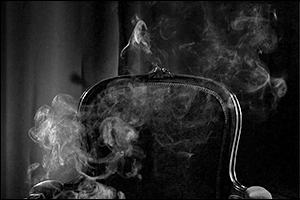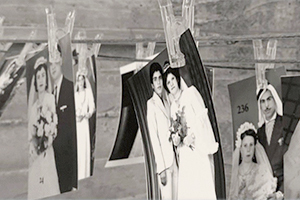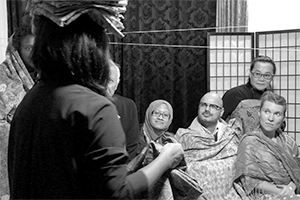LATERNA MAGICA'S OPENING EVENT PHANTASMAGORIA
CAMERA STORIES

THE LIFE OF AN ITINERANT THROUGH A PINHOLE
Behzad Khosravi-Noori
By conducting a historical analysis of archival images from a working-class immigrant community – taken by a local itinerant photographer, Gholamreza Amirbegi – this art project attempts to present the relationship between class identity and means of production in Tehran in the period roughly between 1956 and 1968. On one hand, the archive presents the identity of a social group in the context of the history of the city of Tehran after the Second World War, revealing the effects of the war and the subsequent economic devastation and bankruptcy of smaller cities, but on the other hand it also underlines the entanglements between the global and the local in relation to the effects of grand political events and of foreign film productions, especially Bollywood and Yugoslav partisan films, on an isolated working-class neighbourhood in the south-west of Tehran. By re-narrating the archival materials, signifying subaltern histories of the global south, the project tries to dig into social changes in contemporary history from below, uncovering the unconscious colonial memories that relate to the technological history of image production.
Behzad Khosravi-Noori (1976) is an artist and writer based in Stockholm and Tehran. He graduated from Tarbiat Modares University in Tehran with a Master’s in Motion Picture Studies and received a Master’s in Art in the Public Realm at Konstfack University College of Art and Design in Stockholm. Khosravi-Noori uses personal experience as a springboard to establish, through artistic research, a hypothetical relationship between personal memories and significant world events, between micro and macro histories. His works focus on films and historical materials in order to raise questions such as ‘What happens to narratives when they cross the border?’ and ‘What is the future of our collective past?’. Khosravi-Noori’s research-based practice includes films and installations as well as archival studies.

THE GIFT FROM Khrushchev
Photo Anthropologist Peter Christensen
"In february 1964, my father travelled to the Sovjet Union, where he as an official for the State Department participated in the official state visit together with Prime Minister Jens Otto Kragh.
In Moscow, many long meetings took place in different delegations with Foreign Minister Gromyko and secretary general for the communist party Khrushchev, often eight hours before lunch and eight hours after. When my father arrived at the meetings, he and Kragh's private secretary, Hjortdahl, would walk just behind Kragh and therefore Khrushchev believed them to be Kragh's bodyguards.
My father was appointed head of the Compensation Delegation that discussed the missing compensation to the Danish citizens, from whom the Russians confiscated property in the Baltic countries and Poland in 1940. During these discussions Khrushchev pointed out that those negotiations seemed unfit for a bodyguard to handle.
Kragh on his side noted that he did not bring any bodyguards, but Khrushchev did not believe that. At the end of the meeting gifts were exchanged and my father was very surprised to recieve a camera. But he thinks that the gift relates to Khrushchev believing he was a badyguard and hence would be excited to get a camera.
However my father was not particularly interested in photography so he handed it over to me. At the age of 13 I began photographing with a SLR camera - rare at the time - without a light meter but with an excellent 58 mm lens.
The Zenit camera was the Russian version of the German Leica. For me it was an epiphany to get such a camera and I have been a photo enthusiast ever since, both as an eager amateur and too a smaller degree as a professional. To me Khrushchevs camera was a game changer that shaped my life and a big part of my creative endeavors."

a bicycle ride to germany for a leica
Nanna Steen Jensen
"My grandfather's name was Holger Jensen. He was born i 1902. When he was just 10 years old, he had a box camera, and later on he got several other other cameras, always German. He was a german teacher in primary school and rode a bike around Germany, which he knew quite well as a result. During World War II, he became an eager part of the resistance, and he made a Voigtländer camera with a built in prism to make it possible to photograph around corners. He used this to shoot the German fortifications at Dueodde in all secrecy, where he was the official photographer of the German soldiers. Often, they were placed in a line with my grandfather in the middle who - with his golden locks - looked like the typical aryan boy. Holger produced and copied the secret photos of the fortifications by him self, and afterwards they were shipped to Sweden and from their to England.
Grandfather was always on the look out for a better camera and the Leica was the superior, but they were expensive and hard to come by after the war. Even with his German connections, he did not succeed because the Germans were poor after the war and had sold their Leicas a long time ago - if they ever owned one in the first place.
My father who was trained to be a pilot in the US came to his rescue. He came in contact with an american pilot who was stationed in Germany, and he had an american collegue who probably could be convinced to sell his German Leica. When the deal was made, my grandfather rode his bike all the way to the American base in Germany. At that time, it was the only secure way to transport the Leica back to Denmark.
For many years he shut amazing photos with that camera, until he had a hard time reading the small numbers and letters on the Leica, which at that time was handed over to my father. He also used it for several years before handing it over to me. Now the Leica from the late 1930s has been in use for three generations - and it still produces beautiful photos. It has a 50 mm objective with aperture 1:2 and a resolution of 1000 lines pr. mm, but it takes time to adjust it, so you need patience to photograph with it. In return, the resolution is not surpassed by any modern camera."

from a gun sight camera to the silver screen
Ib Melchior Compilation
From International Military Antiques: "G.S.A.P. (Gun Sight Aim Point) 16mm gun sight movie camera with 35mm 3.5 lens and yellow filter. This camera was the standard United States Army Air Force cine-gun camera during World War II. It was used mostly on fighter aircraft such as the P-51, P-47 and P-38 to record and confirm hits during air to air and air to ground gunnery. The camera operated only when the aircraft's gun trigger button was pressed. This type of camera was also fitted to the remote gun turret aiming controls of the Boeing B-29 heavy bomber.
Fighter pilots tended to make exaggerated claims of successful shoot downs of enemy aircraft, both due to misinterpretation of the actual action and due to overinflated egos.
To record the pilot’s actual success (or lack thereof) in shooting down a target, cameras were installed. These machine gun cameras were synchronized with the nose-mounted machine gun."
Provenance: From the estate of Ib Melchior, son of the renowned Danish opera star Lauritz Melchior. Ib served as an intelligence officer during World War II and was awarded a Silver Star for his capture of the infamous Nazi Werewolves. He later went on to become a noted author and science fiction screenwriter producing such films as Reptilicus and The Angry Red Planet.

a lifelong love for cameras
A love story told by the daughter of a collector
"My father, Knud Vormstrup Madsen, was born in September 1928 and grew up as the son of a merchant in the midst of Århus city. From a very early age, he was fascinated by the camera and its magical world, and he succeeded in landing an apprenticeship in the, at the time, very advanced field of photography under the photographer Hammerschmidt in Århus. Late, as a full-fledged advertising photographer, he spent 10 years working at the advertisement company Harland and Toksvig, which came to be known as ScanAd. From the mid 60ies he worked as a photography teacher at the Technical School in Randers - where he among other subjects taught repro photography - until a stroke in 1990 put a stop to his career.
After spending all his life working professionally with cameras combined with his life long love for the world of cameras at some point made him start collecting cameras, related equipment and literature. He succeeded in cataloguing, photographing and describing about 330 smaller cameras in his collection, which was very broad and in its way illustrated the development of the analogue camera from the early, simple box cameras made of cardboard, to the beautiful ones made in mahogany and brass, and finally the present day’s more streamlined models in plastic and other modern materials. Besides the catalogued, smaller analogue cameras, he also collected a lot of other equipment and a number of different accessories and photographica, all of which we have yet to unpack.
These were objects my father had looked forward to hold and admire with his glasses posed at the tip of his nose. These were objects my father had looked forward to hold and admire with his glasses posed at the tip of his nose.
In 1954, my father worked on a film for Danish Agriculture and Food Council titled På lige hammel, which shows everyday life at a Danish smallholding. During this period, he also made two short films in collaboration with his father in law, actor Karl Stegger, based on H.C. Andersen’s Flipperne and Hvad fatter gør. The latter two movies have since been donated to DFI - Danish Film Institute.
Naturally, the photography also played a part in his private life, which afforded many beautiful slideshows from holidays, great portraits of friends and family and pretty recordings of nature, but also a now historically interesting photo documentation of my grandparents’ living rooms and fine, empty interior photographs from the time of the war, and curious recordings of German soldiers from his bike rides around the occupied Århus - and finally, I must have been the most photographed child of my generation.
My father passed away peacefully surrounded by his family a week before his 87th birthday in 2015."
Lona Stegger Madsen, the daughter of Knud Vormstrup Madsen






